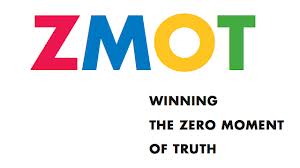How to Make the Zero Moment of Truth Work for You
When faced with multiple products, the time it takes for a shopper to make a purchase decision between them is usually three to seven seconds. These critical moments are known as the First Moment of Truth (or FMOT), and they determine whether or not all the advertising and promotion marketers have invested will pay off. Thanks to the Internet, another critical moment for consumer/brand interactions is also getting attention: the Zero Moment of Truth (or ZMOT). ZMOT encompasses the time between consumers’ first exposure to advertising for a product and the ultimate purchase decision—with emphasis what happens in between those two things: online research of the product.
According to a study by Google (who came up with the ZMOT concept), before deciding whether or not to buy:
- 50% of shoppers used a search engine to get more information on a product or brand
- 38% comparison shopped online
- 36% checked out the brand/manufacturer’s website
- 31% read online endorsements, reviews or recommendations
These behaviors have redefined the way marketers now plan for online shoppers—causing a tremendous shift away from the way they used to plan their campaigns. Marketers who sell high-end goods like electronics, furniture or cars are no strangers to these shopping patterns, but these days, customers apply them to practically everything they buy. Having a good product and a solid awareness campaign is no longer enough; now there’s a more informed and discerning customer base to cater to. They check in with their trusted third-party sources, and expect your message to be consistent from desktop to mobile to tablet and back again. It’s a tall order…but not an impossible one.
Here are some ideas to help win at the Zero Moment of Truth:
Mobile Optimization
Back in the day—uh, about 10 short years ago—marketers knew more about their products than their consumers did, and had the luxury of acting as the gatekeepers of brand information. These days, consumers aren’t as passive; they’re active, engaged and are likely to know as much about what’s being sold as the people selling it to them (if not more). When they have something to say about a product, they’re not just saying it to the company that sold it to them, they’re talking to each other, at an exponential rate.
Mobile tech and devices are crucial to this process. On the go, customers search for store locations, compare prices and features, and call family and friends to get opinions. At home, they’ll respond to a TV or radio ad by firing up search engines on their second screens. So optimizing company websites for mobile is a no-brainer.
Here are some things to consider when doing so:
- Improve page load speeds by leaving out huge graphics and Flash content.
- Make sure your site design translates to smaller smartphone screens as well as it does to larger tablet and desktop ones.
- Use A/B and Multivariate testing on as many site elements as possible—namely, content, design, shopping cart process—to see what gets your mobile audience excited.
- Don’t be afraid to track mobile marketing separately from other web campaigns; according to Google’s study, mobile-only campaigns perform 11.5% better than hybrid desktop/mobile ones.
Brand Credibility
You already know people are talking about your brand on the Web, so you need to do your utmost to embrace and be a part of that conversation.
If people are searching for your brand online with questions, you’d better have useful and engaging answers for them—because if you don’t, your competition surely will. Product reviews and recommendations are major resources for consumers doing research; make sure they’re prominently displayed on the product pages of your website.
Don’t be nervous about opening up your site to user comments and feedback, because honestly…most reviews are good reviews. According to a Bazaarvoice study, 80% of online reviews on a given retail site are written by the top 20% of the site’s most committed and loyal customers. Even the occasional thumbs-down is a good sign; shoppers see negative reviews as proof of an unbiased, truthful environment.
Video is another crucial aspect of ZMOT; product showcases, how-to demonstrations, B2B case studies…whatever your market, customers will want to see what you have on offer before opening their wallets. Shoppers love to send videos to each other via email, post them to social networks or embed them in their blogs or personal websites, so make sure your videos are easy for customers to share. Try adding a YouTube channel to your social media arsenal. Increase the reach of your TV advertisements by posting them online.
Brand Consistency
If there’s no stylistic connection between your company’s main website, your social media pages, and your offline marketing campaigns, shoppers are bound to get confused or challenge the legitimacy of your online presence. Keep branding elements and logos consistent between all your marketing channels, so consumers trust that they’re exactly where they need to be and know precisely who they’re dealing with.
Don’t just pay attention to style—your content also has to be consistent across channels and campaigns. Shoppers are using various pathways to find you; if they see conflicting product descriptions or huge price discrepancies between channels, they’re likely to lose confidence in your brand and look elsewhere. Also, it’s important to keep your online content fresh and updated. If customers keep seeing the same old commentary on your main site, or your social media sites haven’t been updated in months, they might think you’ve gone out of business—and you’ll lose their business.
Personalization
A huge part of succeeding at ZMOT is being able to define and understand your target audience, in order to provide them with specific experiences attuned to their needs. Not only are consumers seeking information about your products, but their searches also allow you to gain insight that helps you give them exactly what they’re looking for.
Use information gathered from website behaviors to create user profiles that can be segmented by various attributes: geography, time of day, viewing device, media channel, web browser, etc. This personalized approach can be as simple (one or two collected insights) or as complex (mathematical algorithms that dynamically adjust and predict displayed content) as your specific campaigns require. Once created, these profiles provide better, more relevant customer engagement.
Product reviews and recommendations come back into play here, because when consumers engaging in ZMOT use them, they’re not thinking of them as opinions from strangers—instead the reviews and recs are perceived as coming from people like themselves, who’ve been in the same situation and had similar questions. Personalization helps online marketers connect consumers with the product advice most suited with their particular need, which can lead to a desired purchase. Those customers can then post their own reviews or recommendations, informing other consumers undergoing their own ZMOT…and the beat goes on.
ZMOT is a fantastic way to gain awareness on customer interest and satisfaction; putting these various methods to work for you will keep your brand in the forefront of shoppers’ minds and attentions, giving you the ability to trounce your competition and make the sale.



